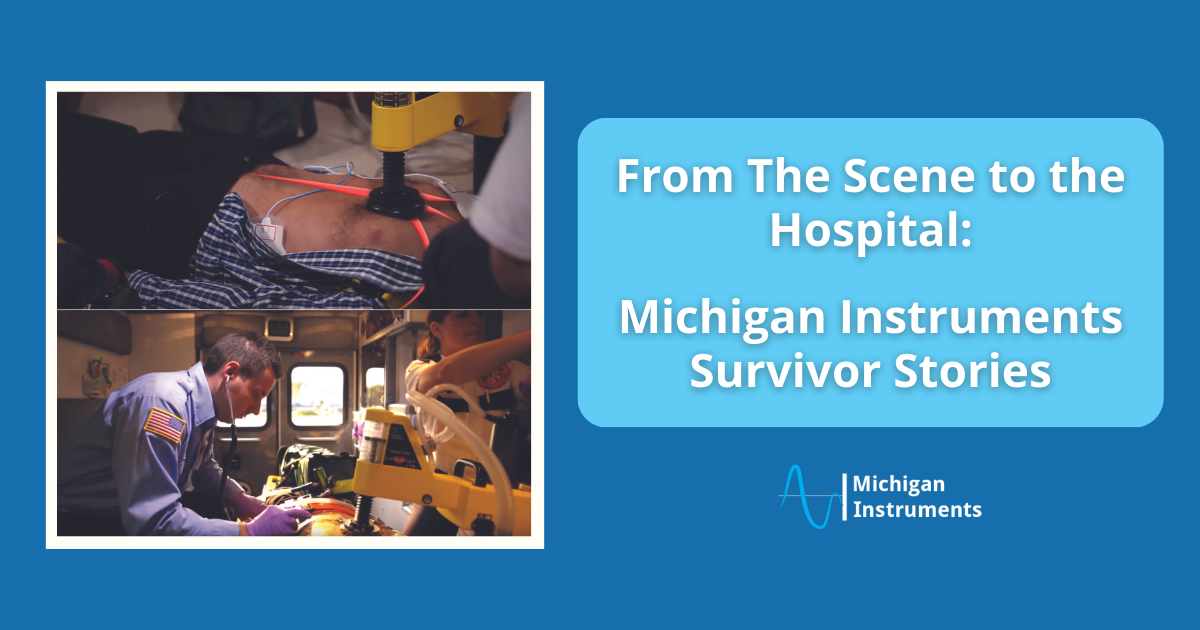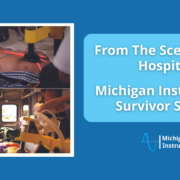
In the world of emergency medical care, every second counts. Swift intervention by emergency responders and bystanders can mean the difference between life and death. It’s because of this urgency that our innovative products, like Life-Stat and Thumper, have become lifelines in critical moments.
The following survivor stories showcase how our breakthrough innovations are rewriting the narrative of medical emergencies and saving lives every day.
Life-Stat and Leonard Osborn’s Miracle
In Farmdale, Ohio, Leonard Osborn faced a harrowing ordeal when he suddenly went into cardiac arrest. His heartbeat went silent for a staggering 16 minutes. The swift response of Osborn’s family, who dialed 911, and the Johnston Fire Department’s use of Michigan Instruments’ Life-Stat mechanical CPR device, turned the tide of fate.
Within minutes of being connected to the Life-Stat, Osborn regained a heartbeat, which is a testament to the Life-Stat’s effectiveness.
The Life-Stat: Michigan Instruments’ Mechanical CPR Device
The Life-Stat isn’t just another piece of equipment; it’s a game-changer in emergency medical care. Lightweight and user-friendly, Life-Stat delivers continuous chest compressions with precision, seamlessly transitioning from manual CPR without disrupting compressions.
”It was amazing to see how it worked and to know how effective of a tool it is.” – Mary Kay Sly, First Responder on Scene.
Osborn’s case highlights its remarkable impact, as noted by Mary Kay Sly from the Johnston Fire Department, who witnessed its life-saving prowess firsthand.
How The Life-Stat Saved Osborn’s Life
“There is no way a person could keep up with the amount of compressions it often takes in a situation like this,” said Dr. Jeffery Bedlion, the medical director for Johnson Township EMS, when asked about using mechanical CPR to save Osborn’s life. Bedlion’s statement emphasizes the superiority of mechanical CPR over manual methods.
The Life-Stat ensures that consistent compressions are delivered, allowing first responders like Osborn’s rescuers to focus on other critical, lifesaving tasks. Osborn’s recovery journey, from clinical death to spontaneous heartbeat, shows just how pivotal the device is in cardiac emergencies.
Julia Sims’ Journey
In Greensboro, North Carolina, Julia Sims faced her own battle with sudden cardiac arrest. After months of subtle symptoms that went unnoticed, the Life-Stat CPR machine became her beacon of hope when she experienced sudden cardiac arrests.
Fortunately, her husband, Jeff, and daughter, Brett, were in the same room when Julia’s arrest hit her. Both immediately sprang into action; Jeff dialed 911 and followed the operator’s instructions on how to manually deliver CPR while Brett assisted.
A Greensboro EMS unit arrived on the scene only four minutes later, and after 12 shocks by a defibrillator and 45 minutes of uninterrupted, automated CPR, Julia defied the odds and emerged from the brink of tragedy.
Undetected Symptoms of Cardiac Arrest Can Become Deadly
Julia’s story sheds light on the importance of recognizing cardiac arrest symptoms, especially in women where symptoms can differ. For months prior to the cardiac arrest that nearly took her life, Julia experienced symptoms that she wrote off as the flu. Now, her dedication to educating others about these silent warnings is a testament to her resilience and the life-saving capabilities of devices like the Life-Stat.
Symptoms of a potential cardiac arrest can include:
- pressure/pain in the upper back
- exhaustion
- Insomnia
- indigestion
- vomiting
Hypothermia Survival with Michigan Instruments
Beyond cardiac emergencies, Michigan Instruments’ impact extends to diverse medical crises. For example, a patient’s survival from severe hypothermia was credited in part to the Life-Stat automated CPR device. This showcases its versatility and effectiveness in many different critical situations.
A 56-year-old man was found unresponsive and face down in the snow one winter day in severe hypothermic condition. He was experiencing ventricular fibrillation, considered the most serious cardiac rhythm disturbance, and his body temperature was just 25 degrees Celsius.
Using the Life-Stat automated CPR Device, an intravascular warming catheter, and an esophageal warming device his temperature rose from 25 degrees to 30 degrees Celsius (77°F to 82°F) after 3 hours and 45 minutes. The patient was given an epinephrine drip and additional shocks, at which time he opened his eyes and moved his extremities.
Only one hour later, he was able to follow commands while still on a ventilator.
CPR Machines Increases Chances of Survival
Although all on the brink of disaster, these survivor stories are underlined in resilience, innovation, and hope. Michigan Instruments’ CPR devices and other breakthrough products aren’t just tools; they are lifelines that bridge the gap between crisis and recovery.
As we celebrate the victories of these patients and our devices, we must also give credit to the first responders, medical professionals, and innovators who make these miracles possible every day.
We will continue to be at the forefront of medical innovation and redefine what’s possible in emergency care. We marvel at the bravery of the survivors for telling their stories, and the profound impact of technology in the realm of healthcare. These stories are incredible reminders that every heartbeat counts, and every second matters.
Learn more about our automated CPR devices and how they can be used in both hospital and pre-hospital settings. Contact us today.




